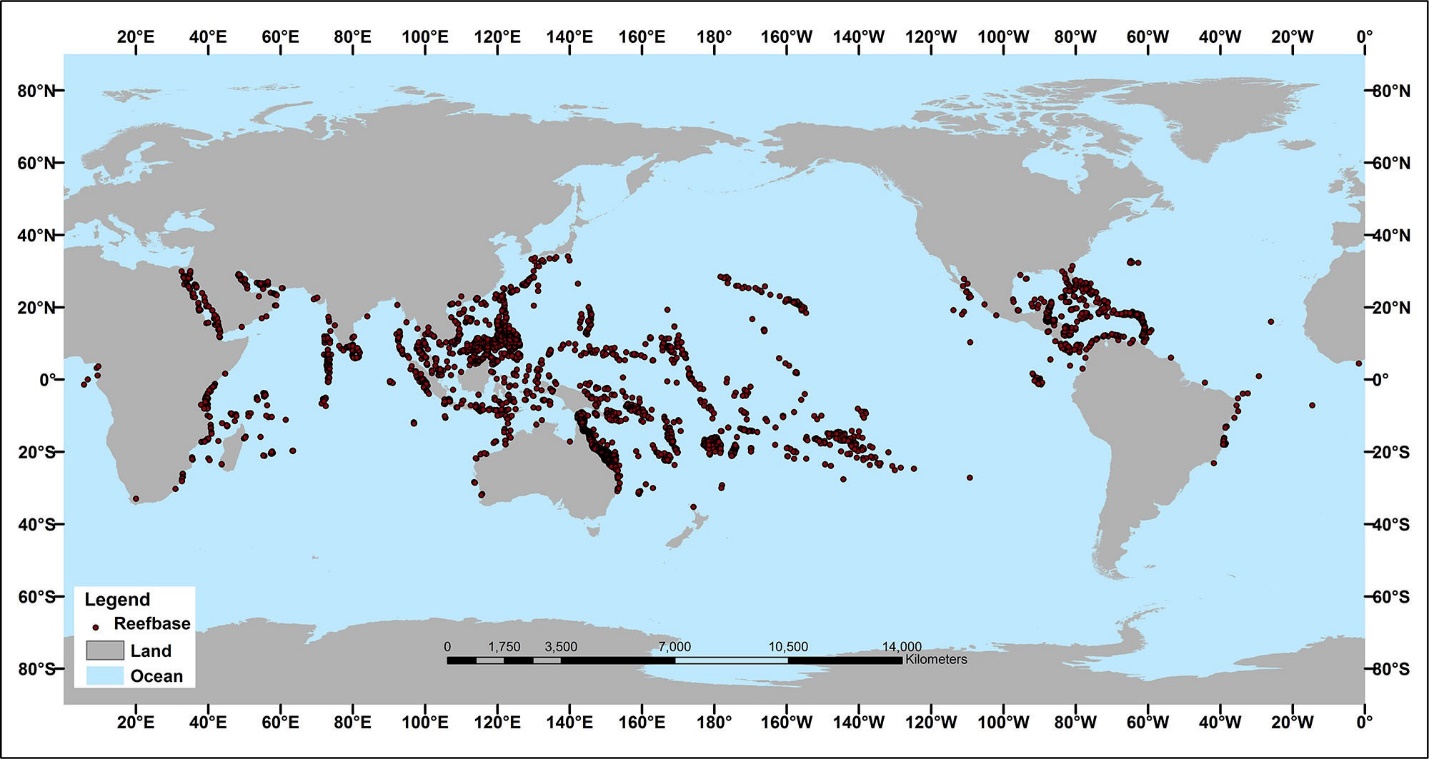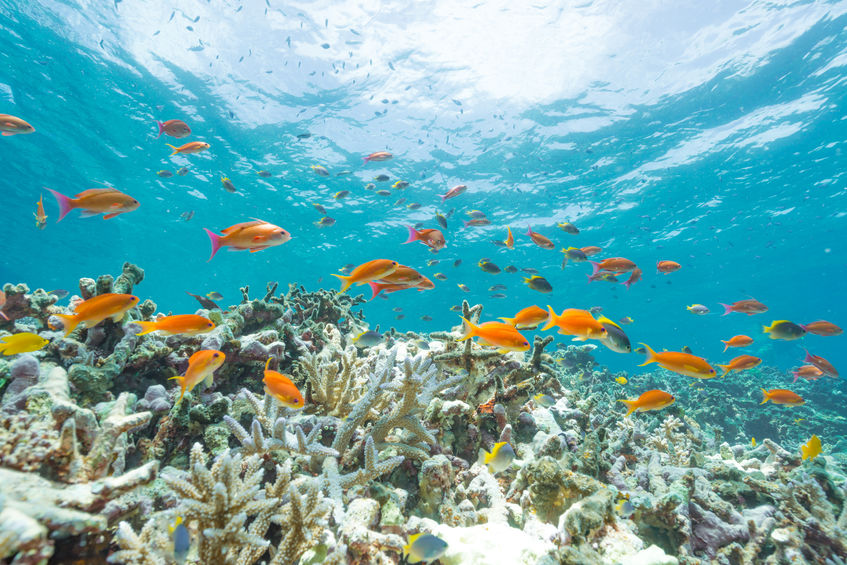Key Takeaways:
- Coral thrive in warm water, not cold water.
- Recent warming has allowed coral to expand their range poleward, while still thriving near the equator.
- Coral has existed continuously for the past 60 million years, surviving temperatures and carbon dioxide levels significantly higher than what is occurring today.
- The primary causes of coral bleaching include oxybenzone (a chemical found in sunscreen), sediment runoff from nearby coastal lands, and cold temperatures like those recorded in 2010 off the Florida coast.
Short Summary:
Corals have existed continuously for at least the past 60 million years.1
The primary reasons for coral bleaching events, which vary significantly depending on the time and location, include sediment and fertilizer pollution from nearby coastal lands, chemicals found in sunscreen (oxybenzone), fertilizer and nitrogen loading from agriculture, and cold temperature events.2,3,4,5 The argument that corals are being decimated by man-created carbon dioxide emissions is easily disproven by the available data. Coral survived, and even thrived, when global temperatures were significantly higher than they are today.6
Short-term strong heat waves or cold snaps can cause bleaching events, but such events have occurred many times in history, including long before humans started producing substantial amounts of carbon dioxide emissions. Moreover, studies show coral can and do adapt genetically, and that they are growing increasingly poleward as earth experiences gradual long-term global warming.7,8
Further, history shows that cold snaps can harm corals much more than warm spells. In 2010, lower-than-usual ocean temperatures off the coast of Florida killed more corals than any warm-water event, destroying more than 40 percent of reef-building corals in the area.9
According to the National Oceanic Atmospheric Administration, “The majority of reef building corals are found within tropical and subtropical waters. These typically occur between 300 north and 300 south latitudes. The red dots on this map show the location of major stony coral reefs of the world.”10
Additionally, many of the stories concerning coral bleaching are not accurate and/or overestimate the problem. For example, the poster child for coral activism is the Great Barrier Reef in Australia. The Australian Institute of Marine Science documented that approximately 22 percent of the Great Barrier Reef experienced bleaching recently, not 93 percent, as reported in some erroneous media stories.11,12
Perhaps most importantly, recent evidence shows much of the bleached corals in the Great Barrier Reef are fully recovering. A study by Peter Ridd revealed that not only are the coral at the Great Barrier Reef recovering, the amount of healthy corals is now at an all-time high.13
Figure 1. Coral Reef Locations Worldwide

Figure 1. (click to enlarge) Corals thrive in the warmest of Earth’s waters. Source: National Ocean Service, “Where Reef Building Corals Found,” National Oceanic and Atmospheric Administration, accessed July 26, 2021, https://oceanservice.noaa.gov/education/kits/corals/media/supp_coral05a.html
UPDATE: map now located at https://serc.carleton.edu/eslabs/corals/4a.html
Quote from the source:
“The majority of reef building corals are found within tropical and subtropical waters. These typically occur between 30° north and 30° south latitudes. The red dots on this map show the location of major stony coral reefs of the world.”
https://web.archive.org/web/20201018031226/https://oceanservice.noaa.gov/education/tutorial_corals/coral05_distribution.html
References:
- United States Geological Survey, Coral Reef Project, “What is a reef?,” accessed Sept 27, 2023, https://www.usgs.gov/centers/pcmsc/coral-reef-facts
- Zenaida Kotala, “Lathering Up with Sunscreen May Protect Against Cancer – Killing
Coral Reefs,” UCF Today, University of Central Florida, October 20, 2015, https://www.ucf.edu/news/lathering-up-with-sunscreen-may-protect-against-cancer-killing-coral-reefs-worldwide/
- D. Lirman et al., “Severe 2010 Cold-Water Event Caused Unprecedented Mortality to
Corals of the Florida Reef Tract and Reversed Previous Survivorship Patterns,” PLOS
ONE, Volume 6, Issue 8, August 10, 2011, https://doi.org/10.1371/journal.pone.0023047
- National Oceanic and Atmospheric Administration, “How Pollution Affects Coral
Reefs,” accessed July 30, 2021, https://celebrating200years.noaa.gov/visions/coral/
side.html
- National Ocean Service, “How Does Land-Based Pollution Threaten Coral Reefs?,”
National Oceanic and Atmospheric Administration, accessed July 26, 2021, https://
oceanservice.noaa.gov/facts/coral-pollution.html
- Hiroya Yamano, Kaoru Sugihara, and Keiichi Nomura, “Rapid Poleward Range
Expansion of Tropical Reef Corals in Response to Rising Sea Surface Temperatures,”
Geophysical Research Letters, February 17, 2011, https://doi.org/10.1029/2010GL046474
- David Polly, “The Eocene Epoch,” University of California Museum of Paleontology
Online Exhibit, accessed July 26, 2021, https://ucmp.berkeley.edu/tertiary/eocene.php
- Mikhail Matz et al., “Potential and Limits for Rapid Genetic Adaptation to Warming in
a Great Barrier Reef Coral,” PLOS Genetics, Volume 14, Issue 4, April 19, 2018, https://
doi.org/10.1371/journal.pgen.1007220
- D. Lirman et al., supra note 3.
- National Ocean Service, “Where Reef Building Corals Found,” National Oceanic and
Atmospheric Administration, accessed July 26, 2021, https://oceanservice.noaa.gov/
education/tutorial_corals/media/supp_coral05a.html
- Brian Kahn, “Bleaching Hits 93 Percent of the Great Barrier Reef,” Scientific American,
April 20, 2016, accessed July 26, 2021, https://www.scientificamerican.com/article/
bleaching-hits-93-percent-of-the-great-barrier-reef
- Michael Slezak, “Agencies Say 22% of Barrier Reef Coral Is Dead, Correcting
‘Misinterpretation,’” The Guardian (U.K.), June 3, 2016, https://www.theguardian.com/
environment/2016/jun/03/agencies-say-22-of-barrier-reef-coral-is-dead-correctingmisinterpretation
- Peter Ridd, “Record Coral Cover of Great Barrier Reef Shames Climate Alarmists,”
Global Warming Policy Forum, July 23, 2021, https://www.thegwpf.com/peter-riddrecord-
coral-cover-of-great-barrier-reef-refutes-climate-alarmists
Climate At A Glance is a Project of The Heartland Institute
View this page in our printable booklet (PDF) here.
Email think@heartland.org
Key Takeaways:
- Coral thrive in warm water, not cold water.
- Recent warming has allowed coral to expand their range poleward, while still thriving near the equator.
- Coral has existed continuously for the past 60 million years, surviving temperatures and carbon dioxide levels significantly higher than what is occurring today.
- The primary causes of coral bleaching include oxybenzone (a chemical found in sunscreen), sediment runoff from nearby coastal lands, and cold temperatures like those recorded in 2010 off the Florida coast.
Short Summary:
Corals have existed continuously for at least the past 60 million years.1
The primary reasons for coral bleaching events, which vary significantly depending on the time and location, include sediment and fertilizer pollution from nearby coastal lands, chemicals found in sunscreen (oxybenzone), fertilizer and nitrogen loading from agriculture, and cold temperature events.2,3,4,5 The argument that corals are being decimated by man-created carbon dioxide emissions is easily disproven by the available data. Coral survived, and even thrived, when global temperatures were significantly higher than they are today.6
Short-term strong heat waves or cold snaps can cause bleaching events, but such events have occurred many times in history, including long before humans started producing substantial amounts of carbon dioxide emissions. Moreover, studies show coral can and do adapt genetically, and that they are growing increasingly poleward as earth experiences gradual long-term global warming.7,8
Further, history shows that cold snaps can harm corals much more than warm spells. In 2010, lower-than-usual ocean temperatures off the coast of Florida killed more corals than any warm-water event, destroying more than 40 percent of reef-building corals in the area.9
According to the National Oceanic Atmospheric Administration, “The majority of reef building corals are found within tropical and subtropical waters. These typically occur between 300 north and 300 south latitudes. The red dots on this map show the location of major stony coral reefs of the world.”10
Additionally, many of the stories concerning coral bleaching are not accurate and/or overestimate the problem. For example, the poster child for coral activism is the Great Barrier Reef in Australia. The Australian Institute of Marine Science documented that approximately 22 percent of the Great Barrier Reef experienced bleaching recently, not 93 percent, as reported in some erroneous media stories.11,12
Perhaps most importantly, recent evidence shows much of the bleached corals in the Great Barrier Reef are fully recovering. A study by Peter Ridd revealed that not only are the coral at the Great Barrier Reef recovering, the amount of healthy corals is now at an all-time high.13
Figure 1. Coral Reef Locations Worldwide

Figure 1. (click to enlarge) Corals thrive in the warmest of Earth’s waters. Source: National Ocean Service, “Where Reef Building Corals Found,” National Oceanic and Atmospheric Administration, accessed July 26, 2021, https://oceanservice.noaa.gov/education/kits/corals/media/supp_coral05a.html
UPDATE: map now located at https://serc.carleton.edu/eslabs/corals/4a.html
Quote from the source:
“The majority of reef building corals are found within tropical and subtropical waters. These typically occur between 30° north and 30° south latitudes. The red dots on this map show the location of major stony coral reefs of the world.”
https://web.archive.org/web/20201018031226/https://oceanservice.noaa.gov/education/tutorial_corals/coral05_distribution.html
References:
- United States Geological Survey, Coral Reef Project, “What is a reef?,” accessed Sept 27, 2023, https://www.usgs.gov/centers/pcmsc/coral-reef-facts
- Zenaida Kotala, “Lathering Up with Sunscreen May Protect Against Cancer – Killing
Coral Reefs,” UCF Today, University of Central Florida, October 20, 2015, https://www.ucf.edu/news/lathering-up-with-sunscreen-may-protect-against-cancer-killing-coral-reefs-worldwide/
- D. Lirman et al., “Severe 2010 Cold-Water Event Caused Unprecedented Mortality to
Corals of the Florida Reef Tract and Reversed Previous Survivorship Patterns,” PLOS
ONE, Volume 6, Issue 8, August 10, 2011, https://doi.org/10.1371/journal.pone.0023047
- National Oceanic and Atmospheric Administration, “How Pollution Affects Coral
Reefs,” accessed July 30, 2021, https://celebrating200years.noaa.gov/visions/coral/
side.html
- National Ocean Service, “How Does Land-Based Pollution Threaten Coral Reefs?,”
National Oceanic and Atmospheric Administration, accessed July 26, 2021, https://
oceanservice.noaa.gov/facts/coral-pollution.html
- Hiroya Yamano, Kaoru Sugihara, and Keiichi Nomura, “Rapid Poleward Range
Expansion of Tropical Reef Corals in Response to Rising Sea Surface Temperatures,”
Geophysical Research Letters, February 17, 2011, https://doi.org/10.1029/2010GL046474
- David Polly, “The Eocene Epoch,” University of California Museum of Paleontology
Online Exhibit, accessed July 26, 2021, https://ucmp.berkeley.edu/tertiary/eocene.php
- Mikhail Matz et al., “Potential and Limits for Rapid Genetic Adaptation to Warming in
a Great Barrier Reef Coral,” PLOS Genetics, Volume 14, Issue 4, April 19, 2018, https://
doi.org/10.1371/journal.pgen.1007220
- D. Lirman et al., supra note 3.
- National Ocean Service, “Where Reef Building Corals Found,” National Oceanic and
Atmospheric Administration, accessed July 26, 2021, https://oceanservice.noaa.gov/
education/tutorial_corals/media/supp_coral05a.html
- Brian Kahn, “Bleaching Hits 93 Percent of the Great Barrier Reef,” Scientific American,
April 20, 2016, accessed July 26, 2021, https://www.scientificamerican.com/article/
bleaching-hits-93-percent-of-the-great-barrier-reef
- Michael Slezak, “Agencies Say 22% of Barrier Reef Coral Is Dead, Correcting
‘Misinterpretation,’” The Guardian (U.K.), June 3, 2016, https://www.theguardian.com/
environment/2016/jun/03/agencies-say-22-of-barrier-reef-coral-is-dead-correctingmisinterpretation
- Peter Ridd, “Record Coral Cover of Great Barrier Reef Shames Climate Alarmists,”
Global Warming Policy Forum, July 23, 2021, https://www.thegwpf.com/peter-riddrecord-
coral-cover-of-great-barrier-reef-refutes-climate-alarmists
Climate At A Glance is a Project of The Heartland Institute
View this page in our printable booklet (PDF) here.
Email think@heartland.org



